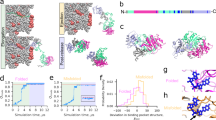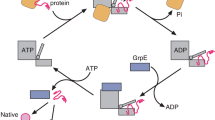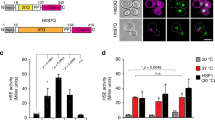Abstract
Two glucose-regulated proteins, GRP78 and GRP94, are major constituents of the endoplasmic reticulum (ER) of mammalian cells. These proteins are synthesized constitutively in detectable amounts under normal growth conditions; they can also be induced under a variety of conditions of stress including glucose starvation and treatment with drugs that inhibit cellular glycosylation, with calcium ionophores or with amino-acid analogues1,2. Unlike the closely-related heat shock protein (HSP) family2–4, the GRPs are not induced significantly by high temperature. Recently, GRP78 has been identified as the immunoglobulin heavy chain binding protein (BiP) (ref. 5 and Y.K. et al., in preparation) which binds transiently to a variety of nascent, wild-type secretory and trans-membrane proteins and permanently to malfolded proteins that accumulate within the ER6–8. We have tested the hypothesis that the presence of malfolded proteins may be the primary signal for induction of GRPs by expressing wild-type and mutant forms of influenza virus haemagglutinin (HA) in simian cells. Only malfolded HAs, whose transport from the ER is blocked, induced the synthesis of GRPs 78 and 94. Additional evidence is presented that malfoldingper se, rather than abnormal glycosylation1, is the proximal inducer of this family of stress proteins.
This is a preview of subscription content, access via your institution
Access options
Subscribe to this journal
Receive 51 print issues and online access
$199.00 per year
only $3.90 per issue
Buy this article
- Purchase on Springer Link
- Instant access to full article PDF
Prices may be subject to local taxes which are calculated during checkout
Similar content being viewed by others
References
Lee, A. S. Trends biochem. Sci. 12, 20–23 (1987).
Subjeck, J. R. & Shyy, T.-T. Am. J. Physiol. 250, C1–C17 (1986).
Pelham, H. R. B. Cell 46, 959–961 (1986).
Schlesinger, M. J. J. Cell Biol. 103, 321–325 (1986).
Munro, S. & Pelham, H. R. B. Cell 46, 291–300 (1986).
Hendershot, L., Bole, D. & Kearney, J. F. Immun. Today 8, 111–114 (1987).
Sharma, S., Rodgers, L., Brandsma, J., Gething, M.-J. & Sambrook, J. EMBO J. 4, 1479–1489 (1985).
Gething, M.-J., McCammon, K. & Sambrook, J. Cell 46, 939–950 (1986).
Chang, S. C. et al. Proc. natn. Acad. Sci. U.S.A. 84, 680–684 (1987).
Kelley, P. M. & Schlesinger, M. J. Cell 15, 1277–1286 (1978).
Hightower, L. E. J. cell. Physiol. 102, 407–427 (1980).
Welch, W. J., Garrels, J. I., Thomas, G. P., Lin, J. J.-C. & Feramisco, J. R. J. biol. Chem. 258, 7102–7111 (1983).
Doyle, C., Roth, M. G., Sambrook, J. & Gething, M.-J. J. Cell Biol. 100, 704–714 (1985).
Gething, M.-J. & Sambrook, J. Nature 293, 620–625 (1981).
Shiu, R. P. C., Pouyssegur, J. & Pastan, I. Proc. natn. Acad. Sci. U.S.A. 74, 3840–3844 (1972).
Elbein, A. D. A. Rev. Biochem. 56, 497–534 (1987).
Schwarz, R. T. & Datema, R. Trends biochem. Sci. 8, 32–34 (1984).
Olden, K., Pratt, R. M., Jaworski, C. & Yamada, K. M. Proc. natn. Acad. Sci. U.S.A. 76, 791–795 (1979).
Whelan, S. A. & Hightower, L. E. J. cell Physiol. 125, 251–258 (1985).
Sciandra, J. J., Subjeck, J. R. & Hughes, C. S. Proc. natn. Acad. Sci. U.S.A. 81, 4843–4847 (1984).
Hiromi, Y. & Hotta, Y. EMBO J. 4, 1681–1687 (1985).
Ananthan, J., Goldberg, A. J. & Voellmy, R. Science 232, 522–524 (1986).
Ting, J., Wooden, S. K., Kriz, R., Kelleher, K., Kaufman, R. J. & Lee, A. S. Gene 55, 147–152 (1987).
Mazzarella, R. A. & Green, M. J. biol. Chem. 262, 8875–8883 (1987).
Lewis, M. J., Turco, S. J. & Green, M. J. biol. Chem. 260, 6926–6931 (1985).
Maniatis, T., Fritch, E. F. & Sambrook, J. Molecular Cloning: a Laboratory Manual (Cold Spring Harbor Laboratory, New York 1982).
Bole, D. G., Hendershot, L. M., & Kearney, J. F. J. biol. Chem. 102, 1558–1566.
Author information
Authors and Affiliations
Rights and permissions
About this article
Cite this article
Kozutsumi, Y., Segal, M., Normington, K. et al. The presence of malfolded proteins in the endoplasmic reticulum signals the induction of glucose-regulated proteins. Nature 332, 462–464 (1988). https://doi.org/10.1038/332462a0
Received:
Accepted:
Issue Date:
DOI: https://doi.org/10.1038/332462a0
This article is cited by
-
A fast-acting lipid checkpoint in G1 prevents mitotic defects
Nature Communications (2024)
-
Endoplasmic reticulum stress and the unfolded protein response: emerging regulators in progression of traumatic brain injury
Cell Death & Disease (2024)
-
Endoplasmic reticulum stress: a novel targeted approach to repair bone defects by regulating osteogenesis and angiogenesis
Journal of Translational Medicine (2023)
-
Control of immune cell function by the unfolded protein response
Nature Reviews Immunology (2023)
-
Discovery of rafoxanide as a novel agent for the treatment of non-small cell lung cancer
Scientific Reports (2023)
Comments
By submitting a comment you agree to abide by our Terms and Community Guidelines. If you find something abusive or that does not comply with our terms or guidelines please flag it as inappropriate.



